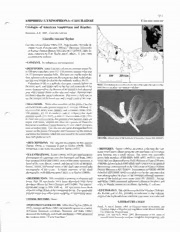
Caecilia volcani PDF
Preview Caecilia volcani
AMPHIBLA: GYMNOPHIONA: CAECILIIDAE n I Catalogue of American Amphibians and Reptiles. Summers, A.P. 200 1. Caecilin volcani. Caecilia volcani Taylor Caecilia 17olcaniT aylor 1969a:3 15. Type locality, "El Valle de Antbn, CoclC, Panamj. (elev. 550 m)." Holotype, University of Kansas Natural History Museum (KU) 203035, adult fe- male, collected by E.H. Taylor and C. Myers, 1l July 1966 (examined by author). CONTENT. No subspecies are recognized. DEFINITION. Adult Cnecilia volcmi are medium-sized (TL to 320 mn~c)a ecilians with 112-124 primary annular folds and 14-37 secondary annular folds. The eyes are visible under the skin, splenial teeth are present, the tongue has dark narial plugs, and the total length divided by the midbody width is 30-37. Coloration in life is a uniform slate gray, vaguely lighter on MAP. Distribution of Coecilia r~nlccmith: e circle marks the type locality. the head. neck, and lighter still on the lips and underside of the other known localities are marked with dots. snout. In preservative, the dorsum of the animal is dark charcoal gray with a lighter shade on the sides and venter. Annular folds are darker than the lateral coloration. The snout is light tan, as are the margins of the lower jaw and a small circle at the vent. DIAGNOSIS. Three other members of the genus Cnecilin are found in the same general region as C. volcatri. Of these, C. nigricrrns has many more primary and secondary folds (150- n 188 primary, 42-62 secondary), and C. i.sfhrnica has more primary annuli (13 1-147). as does C. lertcocepholn (1 18-13 1). In Osaecilia ochrocepholrl, the grooves of the primary folds are edged with black, whereas the other two species of Osaecilia that occur in southern Central America, 0.o sne and 0. elongata, lack secondary folds. Cr~ecilinv olcani can be distinguished from species in the genera Derrtlophis and C;yrnnopis by the tentacle and tentacular foramen, which lies just ventral to the nostril rather than well posterior to it. FIGURE. Dorsal v~c\vo flhc holotypc olCtrc,c.ilitr ~.ol(.(o(rKr U 203035). DESCRLPTIONS. The original description of this species (Taylor 1969a) is reiterated in part in Taylor (1969b, 1972). Subdermal scales were described by Taylor (1972). REMARKS. Taylor (1969a) described collecting the type series with Charles Myers along the soft mud banks of a swampy ILLUSTRATIONS. Taylor ( 1969a, 1972) provided identical area draining into a small stream. The series was ostensibly photographs of a paratype (see also Summers and Wake 2001) given field numbers (ETH-HMS 4689-4697.4697A), but the that included dorsal and ventral views of the entire specimen; a series that was deposited in the Field Museum of Natural History detail of the vent; dorsal, ventral, and lateral views of the head; (FMNH) did not include EHT-HMS 4689, which was designated dorsal, ventral, and lateral views of the skull; and several light the holotype and deposited in the University of Kansas Natural micrographs of the scales. A better exposure of the skull History Museum as KU 203035. Examination of FMNH 189208 photographs, with different pencil lines, is in Taylor (1969b). (labelled EHT-HMS 4692) revealed it to be the specimen that was photographed in place of the holotype,although measure- DISTRIBUTION. This caecilian is endemic to Panatnli and ments of the holotype were made from KU 203035. Savage fewer than 20 specimens have been deposited from three and Wake (2001) presented additional collection localities and provinces (Bocas del Toro. Chiriqui, and CochlC). The species' a key to Middle American caecilians, including C. ~lolcani. elevational range is 500-1 100 m. All specimens have been collected within 20 km of the continental divide. The apparently ETYMOLOGY. The species is named for Volcanus (Vulcan), disjunct range may reflect poor sampling of intervenin- -g areas. the Roman god of fire, probably in reference to the volcanic origin of the highlands from which the type series was collected. FOSSIL RECORD. None. LITERATURE CITED f- ' PERTINENT LITERATURE. Other than Taylor (1969a, b, Frank, N. and E. Ramus. 1995. A Complete Guide to Scientific and 1972). Savage and Wake (200 I) included the species in a survey Common Names of Reptiles and Amphibians of the World. NG Publ. of Central American caecilians, Summers and Wake (2001) Co., Pottsville, Pennsylvania. discussed the holotype, and Frank and Ramus (1995) proposed Savage. J.M. and M.H. Wake. 2001. Reevaluation of the status of the common name, "Cocle Caecilian." taxa of Central American caecilians (Amphibia: Gy mnophiona), with comments on their origin and evolution. Copeia 2001:52-64. ADAM P. SUMMERS, Department of Integrative Biology and Summers, A.P. and M.H. Wake. 2001. A clarification regarding the Museum of Vertebrate Zoology, 3060 Life Sciences Bldg., Uni- holotype of caecilia volcani (Amphibia: Gymophiona), Copeia versity of California, Berkeley, CA 94720-3140 (asummers@ 2001:556-560. Taylor, E.H. 1969a. A new Panamanian caecilian. The University of uci.edu). Kansas Science Bulletin 48:315-323. -. 1969b. Skulls of Gymnophiona and their significance in the taxo- Primary editor for this account, Marvalee H. Wake. nomy of the group. The University of Kansas Science Bulletin 48: - - 585-687. Published 30 June 2001 and Copyright O 2001 by the Society -. 1972. Squamation in caecilians, with an atlas of scales. The Univer- for the Study of Amphibians and Reptiles. sity of Kansas Science Bulletin 49:989-1164.
